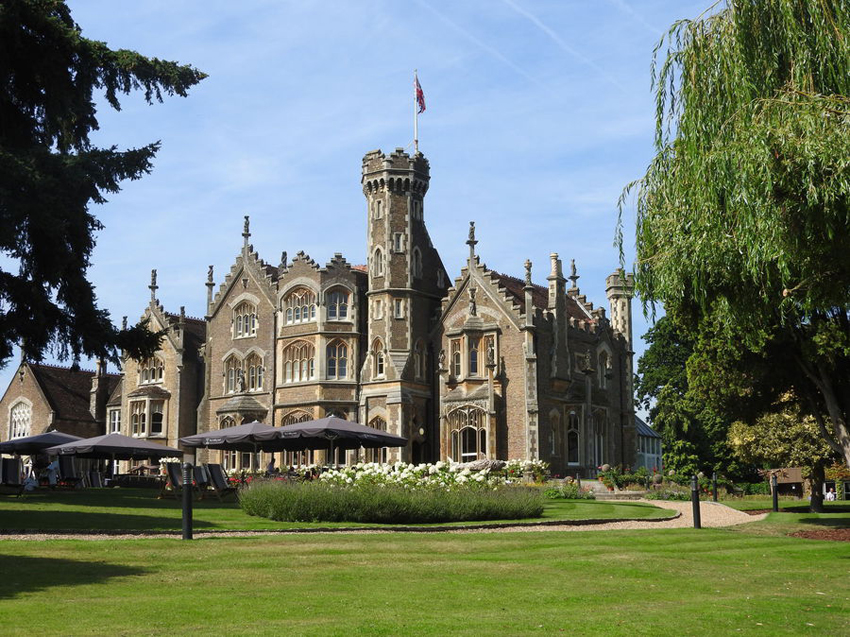
On the banks of the Thames, and set in over 30 acres of grounds, Oakley Court Hotel’s 19th century Gothic Revival architecture certainly creates a distinctive impression. This splendid Grade 2 listed building was originally built as a family home by Sir Richard Hall-Say, High Sheriff of Berkshire, but in more recent times it has been pressed into service as the alleged home of the World War 2 French resistance and then later as a film set for Bray Studios. New owners, however, have recently invested heavily in the fabric of the building and grounds, and the interior is reliving former glories. The reinstatement of the kitchen gardens, the rejuvenation of the orchards and the introduction of bee hives are all contributing to the running of the restaurant and kitchens, whilst the possibility of keeping livestock is being investigated for the future.
 The recent refurbishment of the Dining Room in natural shades and with bare polished floorboards has created a calm, almost pared-down atmosphere. The clean lines of the wooden paneling and dado rail, the classically restrained sideboards and indeed, the initial absence of cutlery on the table contribute further to a feeling of understated elegance. Ornamentation is confined to the cane backed and Empire inspired designs of the chairs. In contrast a spectacular driftwood sculpture by James Doran-Webb of a leaping hare occupies the centre of the dining room, adding a focus of contemporary extravagance.
The recent refurbishment of the Dining Room in natural shades and with bare polished floorboards has created a calm, almost pared-down atmosphere. The clean lines of the wooden paneling and dado rail, the classically restrained sideboards and indeed, the initial absence of cutlery on the table contribute further to a feeling of understated elegance. Ornamentation is confined to the cane backed and Empire inspired designs of the chairs. In contrast a spectacular driftwood sculpture by James Doran-Webb of a leaping hare occupies the centre of the dining room, adding a focus of contemporary extravagance.
The restaurant, however, is still a work in progress and plans are afoot to redesign the remaining dining areas along similar lines and to link them with the new, delightfully presented New England style breakfast room.
Central to the revival of Oakley Court as a destination restaurant has been the appointment two years ago of a new Executive Chef.
Damian Broom is energetic, confident and highly talented. He is also modest and self-effacing. You will not his photo on the hotel’s website and will have to search hard on Google Images. Yet, after sampling his creative cuisine and chatting with him at interview, you will understand why he wants his “food to do the talking.” His cooking reflects the passion, inspiration and dedication that are integral parts of his character.
Damian’s two years at Oakley Court, with the second year developing the 2 AA rosette Dining Room, have been rewarded with two distinctions: Berkshire and Buckinghamshire Life Restaurant of the Year and Chef of the Year for 2015. Given the intense competition in these two affluent counties, replete with high end restaurants, this is no mean achievement. Typically, Damian almost didn’t attend the ceremony as it meant closing the kitchen for the evening. There is also no mention of the awards on the hotel’s website.
Realistically, Damian views his role not as a job, but a whole way of life. He oversees The Dining Room, The Scullery (brasserie), the Bar and the soon to open Terrace, all of which cater for a variety of business and leisure clients of all age ranges. In the busy summer season there may well be 200 guests during the day with a further 100 at night
His major project, the kitchen garden, is well under way, whilst foraging and bee keeping add to his wild larder. In all these activities he has been aided by a small loyal team, including sous chef Scott Meaden, most of whom followed him from Danesfield House, and by his wife who is also a chef and fully appreciates the pressures of the industry. Future plans include extending the three acre kitchen garden, developing poly tunnels located at his father’s allotment, and ultimately – a very long term project – rearing his own livestock. Provence of ingredients is fundamental to his food philosophy, and, although he accepts he cannot be 100% self-sufficient, he aims to maximise the potential.
The latest innovation is the Supper Club on the last Friday of each month featuring a surprise multi course dinner of experimental dishes with interaction between chefs and guests around a communal table
Largely self-taught on the basic skills – which he laments many young aspiring chefs lack – Damian refined them at the Old Vicarage Hotel in Shropshire and at Danesfield House in Marlow, where he retained the Michelin Star and won other awards. His distinctive style, blending rusticity with sophistication has developed without the need to ape the trends of past and current chefs.
The use of the highest quality, sustainable, ultra-seasonal, local organic produce is axiomatic. The sourcing of ingredients is proudly displayed in detail alongside the menu. Line caught fish from his supplier in Cornwall can arrive at the hotel four hours after a phone call made at 5.30 am. Closer at hand is Jerry Rock butchers whose exceptional quality meat is well known in the area. For Damian, the breed and age of livestock are also important, with cows of seven to eight years being preferred. Beef aged for 130 days is a prized item in his larder. Herbs, flowers and honey are provided in house.
Not a slave to fashion, Damian scoffs at foodie trends such as foraging becoming an industry in itself, with professional foragers, and the ubiquitous use of micro herbs which add nothing except a decorative flourish to a dish.
Cooking techniques are classical with minimum use of faddish techniques: indoor wood and charcoal barbeques are preferred to sous vide. The timing of dishes is well judged, with accurate seasoning and harmonious combinations of ingredients. Balance of flavours and textures, with the use of less popular meats or parts of the animal, feature in savoury dishes. Vegetables are given the same care and attention as meat and poultry and may star as a course in their own right. Desserts may showcase varying tastes and temperatures, being refreshing and not overly sweet. Damian modestly describes his food as “simple” but this only applies to the relatively few ingredients in each course and the plating of dishes which has a natural feel without being contrived and over thought. Clearly, from conception to execution, each dish, from the dainty amuse bouches to the more robust and hearty main courses and refined desserts, is labour intensive, involving precise timing and meticulous attention to detail. Menu descriptions are sparse, giving no idea of the cooking method or cuts of meat, allowing an element of surprise when the dish is served.
Accompaniments are made from scratch: The culture for the sourdough bread is also home grown, starting life with apples in the orchard left to acquire naturally the essential wild yeast needed for the fermentation. Butter from 54% fat Jersey cream is made once a week and aged for a week. Milk curd is made a few hours before service.
Imagination and creativity are abundant in the constantly changing tasting menus offered from Wednesday to Saturday dinner. Hardly any dish figures twice (it has only happened with a duck and chicken dish), hence there is no signature dish. Ideas for menus are developed in the previous week, constrained only by what can be grown, bought and stored. Key ingredients can be cooked and presented in a totally different way from the previous evening. Thus, meals are prepared from zero each day, the tasting menu at £65 for seven courses being taken by 80% of the guests. A three course Market Menu at £38 includes dishes from the tasting menu. Prices are realistic, given the quality of the produce and the skill in cooking.

Fine Dining Guide visited on a weekday evening in February and found much to admire in the cooking and service of the tasting menu. A unique feature on the table is a magnificent box from which diners take their own cutlery.
Amongst the delicate, finely crafted canapes were garnished crisp fish and chicken skins, a warm, flavoursome duck confit croquette and a rich Parmesan cream centred “Oreo” which simply melted in the mouth.

Home baked sourdough made with London Pride bitter was exemplary in its firm crust and gently tangy crumb. Served with a deeply flavoured but light savoury broth of mushrooms, leeks and seaweed, it was inspired by Damian’s childhood suppers in the north of England
The first starter comprised very young Jersey royals, with their waxy texture and uniquely sweet flavour, partnered with various caramelised baby onions, and garnished with leek ash and leek oil. Fresh milk curd gave a lactic note to balance the earthiness of the vegetables, a scattering of Naggalo Nero herbs added freshness and colour, whilst a light jus brought the elements together. (Wine: Guardsman , Windsor and Eaton Brewery)
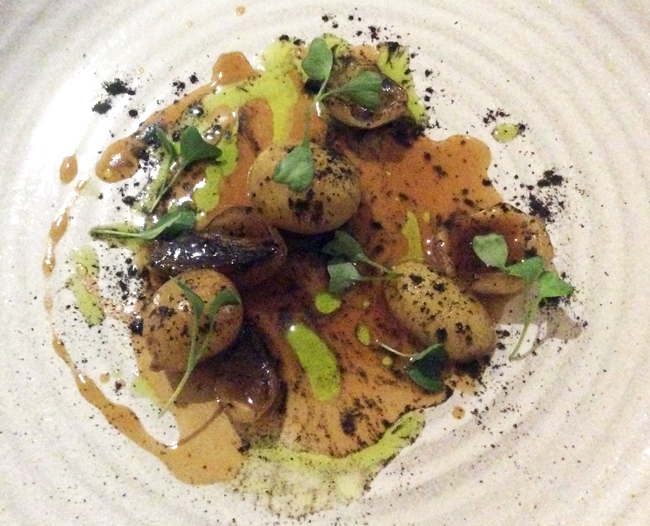
A second starter featured another happy marriage of free range chicken and leek heart. The sweetness of the thigh meat, poached in a lemon thyme to maximise its succulence, contrasted with the crispness of its skin and the richness of its heart. Burnt onion puree had a smoky sweetness and sorrel leaves added a hint of acidity the dish needed. (Wine: Fleury la Roilette Vignes Bernard Metrat, Beaujolais, 2014)
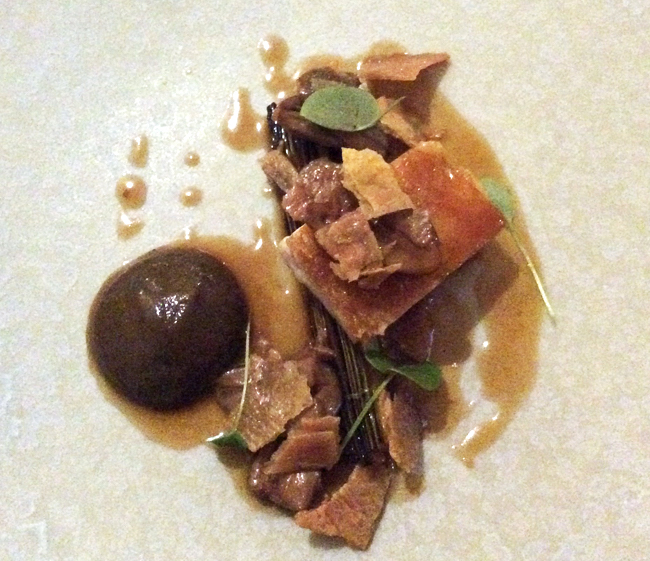
The first main course combined the bounties of earth and sea. An accurately timed Turbot fillet, with translucent flakes of firm sweet flesh, worked well with sweet nuttiness of roasted chervil root and crisp artichoke skin. An inspired touch of luxury saw Russian caviar, which acted as a seasoning, mixed with an artichoke puree of velvety smoothness. (Wine: Louis Latour Montagny 1er Cru, Burgundy, 2012)

This was followed by a less utilised but nonetheless delicious meat. A tranche of mutton was cooked medium rare, its distinctly strong but not overpowering flavour enhanced with the addition of Ortiz anchovies – another classically inspired pairing. Braised Little gem lettuce benefited from caramelised Parmesan topping, helping to add texture and richness to the dish. A lamb fat jus successfully rounded off the plate (Wine: Cote du Rhone Famille Perrin, Rhone, 2012)
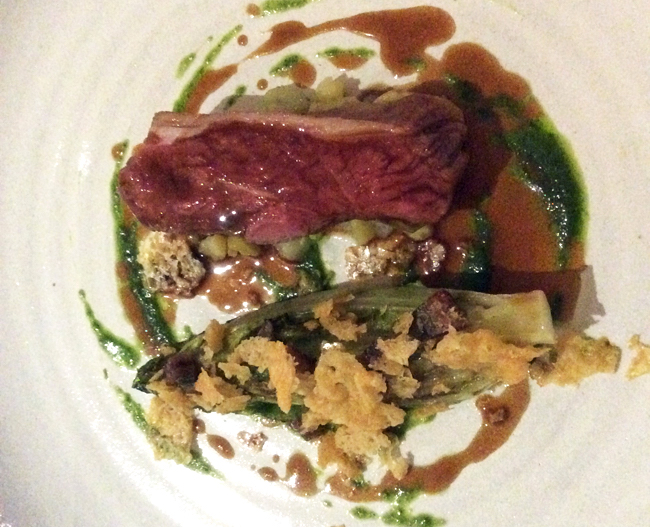
It’s a confident chef who offers only a single cheese as a course, even in a tasting menu. However, Mrs Bell’s Blue with its creamy texture and strong, salty piquancy offered a taste sensation when matched with honeycomb from the hotel’s hives. (Wine: DR Rieseling 2012)
A pre dessert of yogurt espuma – one of the few concessions to contemporary techniques – came with “last year’s blackcurrants” and a granita of dill. This perfectly balanced combination of sweet, acidic and herbal elements served its purpose in being light and palate cleansing. (Wine: Tattinger Nocturne, Demi Sec, France)
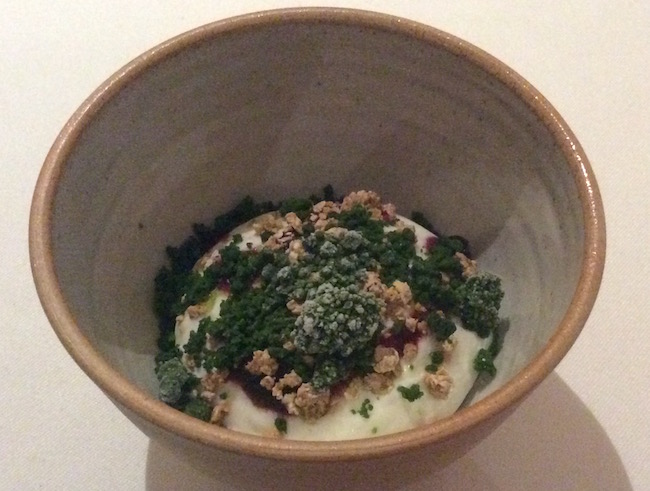
The main dessert featured sliced poached rhubarb, shards of milk crisp, apple marigold and a crème fraiche sorbet topped with a rhubarb syrup. It delighted in its simplicity and combination of sweet and gently acidic elements (Vergelegen Straw Wine, Somerset West, South Africa)

Homemade petit fours, which embraced the diverse flavours of Sea Buckthorne, olives, white chocolate, lemon and honeycomb confirmed the strength of the pastry section and completed an excellent meal.
The whole experience was enhanced by the engaging and knowledgeable service of Shaun and Head Waiter Angelo who served the wines and coped admirably describing their provenance.
Overall, Damian Broom and his team have created a dining experience of which they can be justifiably proud. Given the hotel’s proximity to London, the Dining Room can expect to see increased custom as news travels of its strengths. Surely a third rosette is overdue whilst a Michelin star would justifiably crown the achievement. Fine Dining Guide will certainly return to Oakley Court and will follow its progress with interest.



